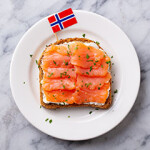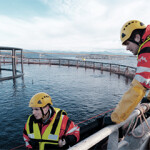Japan’s latest whitepaper highlights another drop in seafood consumption

Japan’s Fisheries Agency recently released its annual Fisheries Whitepaper examining the country’s seafood trends in 2021 – while also setting new policies for 2022.
The whitepaper covers a huge range of data on the seafood industry in Japan from 2021, and also includes new data from 2020 that was previously unavailable.
The whitepaper shows that per-capita consumption of seafood in Japan has dropped over the past two decades. In 2001, per-capita consumption was 40.2 kilograms, but it has since steadily has declined – falling below per-capita consumption of meat in 2011. In 2020, per-capita consumption fell to 23.4 kilograms, which the whitepaper attributes to consumers being deterred from buying seafood by high prices and the labor involved in cooking.
The whitepaper found that ecolabels popular in Japan are the Marine Stewardship Council (MSC), Aquaculture Stewardship Council (ASC), and Marine Eco-Label (MEL). By the end of March 2022, MSC had certified 12 fisheries in Japan – two more than the previous year – for scallops, bonito, albacore tuna, and oysters. The paper found that 313 business operators have obtained Chain of Custody (CoC) certifications, 13 more than previously. ASC has certified 14 aquaculture businesses operating 81 farm sites, for oysters, yellowtail, and Japanese amberjack; along with 164 CoC certs for an increase of 1 and 13, respectively.
The MEL – a Japanese certification that was granted Global Sustainable Seafood Initiative recognition in 2019 – has certified 14 fisheries covering sockeye salmon, mackerel, and shijimi clams; as well as 53 aquaculture business covering Japanese amberjack, yellowtail, sea bream, coho salmon, and yellowtail amberjack. This represents an increase of 7 and 12, respectively. The standard’s CoC certifications grew by 42, to 100. Overall, the MEL has seen more rapid growth than MSC in Japan.
Imports of marine products were down 2.3 percent in volume from the previous year, but up 10 percent in value. The highest import values, in order of share, were for salmon and trout at 13.4 percent, bonito and other tuna at 11.6 percent, shrimp at 11.1 percent, processed shrimp products at 4.5 percent, crab at 3.6 percent, cod at 3 percent, and squid at 2.9 percent. The relative percentages have not changed much in the last several years, even under the influence of COVID-19.
Japan’s major suppliers were, by share of overall value, China at 18 percent, Chile at 9.2 percent, Russia at 8.6 percent, the U.S at 8.3 percent, Norway at 6.9 percent, Vietnam at 6.7 percent, Thailand at 6.1 percent, Indonesia at 4.6 percent, and South Korea at 4.4 percent.
Japan’s main exported marine products were scallops at 21.2 percent, yellowtail at 8.2 percent, mackerel at 7.3 percent, bonito and other tuna at 6.8 percent, pearls at 5.7 percent, processed sea cucumber at 5.1 percent, fishpaste products at 3.7 percent, and processed scallop products at 2.7 percent. Top customers were Hong Kong at 22.1 percent, China at 19.6 percent, the U.S at 14 percent, Taiwan at 8.9 percent, Thailand at 6.8 percent, Vietnam at 6.8 percent, and South Korea at 5.8 percent.
Japan’s fishing and aquaculture production volume has steadily declined since its peak in the late 1980s, due to a collapse of the domestic sardine stock and the implementation of a 200-nautical-mile exclusive economic zone by most countries. The declining population, and a lack of successors in the fishing industry, have also played a part. Since the fisheries’ collapse, sardines have seen a slight recovery and there was a rise in the value of aquaculture from around 2013 to 2018 that bumped up the overall figures – but afterward the figures trend downward again.
Data for the pandemic year of 2020 showed that the average income of a private owner of a fishing boat declined by about 30 percent from the previous year, to just JPY 1.35 million (USD 10,078, EUR 9,383) – including non-fishing income. The average company operating a fishing boat or fish processing facility in 2020 suffered a loss of JPY 9.58 million (USD 71,482, EUR 67,305), including non-fishing income. Aquaculture fared better, with private operators earning an average of JPY 5.27 million (USD 39,322, EUR 37,025).
Fuel costs have risen quickly, triggering a government subsidy. After falling to about JPY 60 (USD 0.45, EUR 0.42) per liter in 2020, heavy oil had risen to JPY 109.1 (USD 0.81, EUR 0.77) by March 2022.
The fishery workforce is shrinking, though the percentage of workers aged of 39 or younger has been on a very slow uptrend as the elderly retire. Productivity per worker has seen two significant bumps: in 2006 and 2007 the coastal fishery saw strong catches, and from 2013 to 2016 aquaculture revenue rose before trending slightly downward.
The government is trying to encourage long-term gains in productivity by applying digital technology, artificial intelligence, and drones to the fishery. One urgent application is real-time digital reporting of catch data at landing using tablet computers to better manage fisheries using up-to-date maximum sustainable yield (MSY) calculations. In the past, data was accumulated at the local level using paper-based systems, so by the time the data was digitalized and analyzed, fishery managers were often working from the previous year’s data.
For aquaculture, environmental monitoring and the automated relay of information, such as about red tides, will be implemented. Automated feeders will also monitor fish growth to optimize feed cost and conversion rates.
In the capture fisheries, monitoring of sea conditions, such as by buoys equipped with sensor, will predict the best fishing grounds and energy-saving routes.
As the number of fishermen declines, the government is encouraging the merger of local fishery cooperatives to maintain a minimum number of active members. The number of fishery cooperatives that were merged jumped in 2020 to 63, after a lull in mergers in the previous decade.
On the distribution side, the number of wholesale markets at fishing ports is stable, but the amount of product sold through wholesale markets in consumer areas is declining, as more purchasers, such as restaurant chains and supermarkets, buy directly.
Processing of edible marine products has declined for two decades, reflecting lower domestic catches of the raw materials. The government aims to match seafood products to consumer needs by promoting those that are convenient, easy to eat, and have less fishy smell. An example would be boneless fish in sauce packed in a retort pouch.
As a general rule, all food businesses, including seafood processors, were required to be HACCP (hazard and critical control point quality control system) certified by June of 2021, and the government has been supporting renovation of facilities required to achieve this. As of the end of March 2022, the number of fish processing plants that have been certified for export to the European Union (EU) was 101, and that for the U.S. was 538.
Japan is also in the process of switching many species from a total allowable effort (TAE) management system (e.g., setting gear type and season length) to a total allowable catch (TAC) system. To do this, more resource evaluations – including setting of MSY for more species – are required. In fiscal year 2021 the number of fish species subject to resource evaluation was expanded from 119 to 192. These were then categorized as having high, medium, or low stock status.
The low status covered 56 percent of the species and included conger eel, deep sea smelt (Glossanodon semifasciatus), 7-band grouper, and tiger pufferfish. The 18 percent of species in the high status included sardines, Pacific cod, Spanish mackerel, and arrow squid.
Japan will also allocate individual vessel quotas. This has already been done for mackerel and spotted mackerel, sardines in Hokkaido, and large bluefin tuna. From FY2022, individual quotas will be applied to target species for which TAC is set that are selected by the Minister of Agriculture, Forestry and Fisheries. From 2023, in principle, IQ will be applied to all target species managed by TAC.
Policies for FY2022 include the following:
- For fishery resource management: Increase surveys and stock assessments, promote the new management scheme, control poaching, and adapt management to the changing environment.
- To grow the industry: Upgrade fishing vessels and build up aquaculture. Develop fishing ports to support exports.
- To revitalize fishing villages: Strengthen the management of fishery cooperatives, and demonstrate the multiple roles of the fishery industry and fishing villages, such as conservation of the ecosystem.
- For sustainable development of the fishing industry: Utilize smart fishery technology and reduce carbon emissions.
Photo courtesy of JinFujiwara/Shutterstock






Share